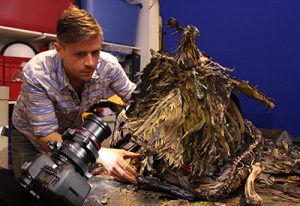For anyone who has ever found themselves spellbound by the clockwork movements of a miniature world, or drifted into an incurable interest when Tim Burton’s The Nightmare Before Christmas happened to pop up on TV in October, last weekend’s 10th annual Festival Stop Motion Montréal was a goldmine.
At the head of this rolling monument to the patience and creativity of stop motion artists is Erik Goulet, an aficionado of the meticulous medium and architect of the festival since its inception in 2009.
This year’s presenters were too numerous to list, with nearly 60 films from 23 countries competing in six different categories. Adorning the crown of the festival was a series of masterclasses intertwined with workshops, interactive programs, free activities, lectures, and more, all in Concordia’s EV building and J.A. de Sève Theatre.

Two highlights of these masterclasses were Amanda Strong, who is based out of unceded Coast Salish territory, commonly known as Vancouver, B.C., and Tim Allen, a veteran of the stop motion and animation industry.
Strong premiered her new film, Biidaaban (The Dawn Comes) and gave a special opening lecture on Sept. 14.
Drawing from the continued displacement, disruption, and distrust that reverberates in First Nations communities from the days of colonization by European empires, Strong’s work deals with the current state of affairs for various groups of Indigenous peoples. A common theme in Strong’s work is to showcase the effects of colonization and how it continues to be felt indirectly by First Nations youth.
Strong encapsulates these feelings in beautifully constructed short films that generally follow a youth enveloped in a struggle with invasion. Delivered in haunting gusts of scenes perfect for her medium of stop motion (though she often splices it with other media), Strong displays a dedication to stop motion.
Biidaaban centres on a gender-fluid Indigenous youth capable of temporal visions and a shape-shifting sasquatch who seeks out sugar Maplewood sap in urban Ontario. This ambitious work is doubtlessly as beautifully sequenced as her earlier films, such as How to Steal A Canoe and Indigo. Biidaaban follows a familiar pattern of representing the echoes of the past that still sound in the hearts and minds of today’s Indigenous youth, and will serve as a reminder of troubles too easily unseen.

Complementing Strong’s onset to the festival was Tim Allen’s culminating masterclass on Sept. 16, which focused on the many well-known productions to which he has lent his expertise, including Corpse Bride, Shaun the Sheep and Frankenweenie. Allen’s most recent contribution to the industry came to a crest in Wes Anderson’s recent film, Isle of Dogs. Allen is a specialist in puppet animation and has been utilizing his skills in the animation film industry since the early 80s. His masterclass was a diffusion of pointed information and anecdotes from his experience in the field.
Between the plenty of lectures, screenings, workshops, and seminars there was something for everyone at this year’s Festival Stop Motion Montréal.




